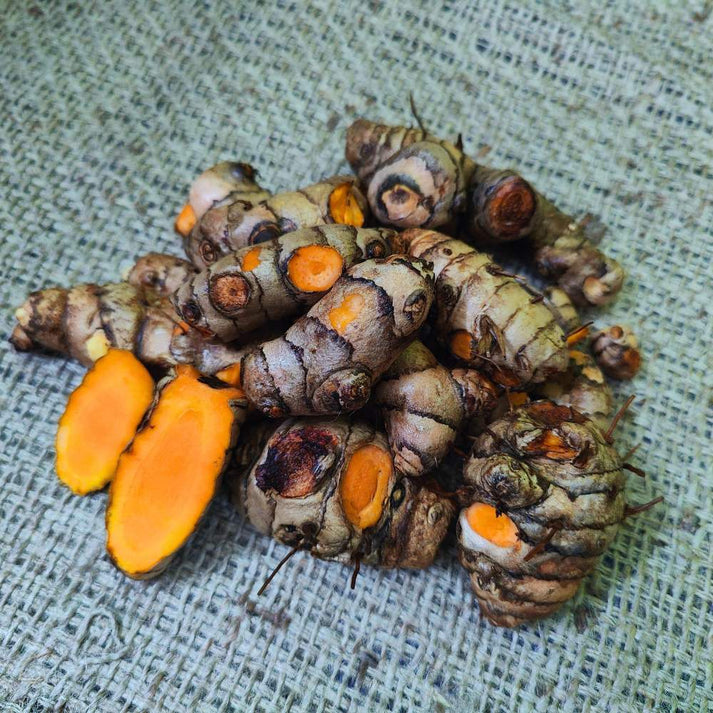
Dharaseeds
Yellow Turmeric Seeds
Estimated Free Delivery between April 16 and April 19.
Secured Payment Methods
Your transaction is protected with advanced security measures to keep your information confidential
Yellow Turmeric (Curcuma longa) is a vibrant and flavorful spice widely known for its medicinal properties and culinary uses. Cultivating your own turmeric allows you to enjoy fresh, aromatic rhizomes that add depth and warmth to dishes while providing a variety of health benefits. Yellow Turmeric thrives in tropical and subtropical climates, making it ideal for warm-weather gardeners. The plant’s bold yellow flowers and lush green foliage also provide aesthetic value in the garden.
Key Benefits
Culinary Use: Fresh turmeric has a more potent flavor than store-bought dried powder, offering vibrant color and depth to curries, stews, and beverages.
Health Benefits: Known for its anti-inflammatory and antioxidant properties, turmeric is often used in natural remedies and health supplements.
Rich in Curcumin: The active compound curcumin, found in turmeric, offers numerous health benefits, including supporting digestion and immune function.
Easy to Grow: Yellow Turmeric is relatively low-maintenance and can be grown both indoors and outdoors, making it accessible to a variety of gardeners.
Tropical Aesthetic: Adds beauty to your garden with its lush green leaves and vibrant yellow flowers.
Variety Features
- Plant Characteristics: Yellow turmeric has large, elongated green leaves and striking yellow flowers that resemble orchids, creating an attractive addition to any garden.
- Rhizome Growth: The plant produces underground rhizomes that are harvested for culinary and medicinal purposes.
- Bloom Period: The plant produces flowers during the late summer to early fall, though the focus is typically on the rhizomes for harvest.
- Size: Typically grows 3–4 feet tall, with a spread of 2–3 feet.
Planting Instructions
Planting Season
- When to Plant: Plant turmeric in the spring after the last frost, or in early summer in warm climates where temperatures remain above 70°F (21°C).
- Ideal Temperature: Thrives in warm temperatures between 75°F–95°F (24°C–35°C), with a growing season of 8–10 months.
Planting Details
- Seed Depth: Plant rhizomes (or turmeric "seeds") about 2–3 inches deep in rich, well-draining soil.
- Spacing: Space rhizomes 12–15 inches apart to allow for optimal growth.
- Soil Requirements: Prefers fertile, well-draining soil with a pH of 6.0–7.0. Adding organic matter or compost will improve soil quality.
- Sunlight: Requires full sun to partial shade. It thrives best in bright, indirect light or filtered sunlight.
Care Instructions
Watering
- Keep the soil consistently moist but not soggy. Water regularly, especially during dry periods, but ensure the soil drains well to prevent waterlogging.
- Turmeric does not tolerate standing water, so good drainage is essential.
Fertilization
- Apply a balanced fertilizer (e.g., 10-10-10) at planting time and every 6–8 weeks during the growing season to support healthy root and leaf growth.
- Organic compost or well-rotted manure is also beneficial for enriching the soil.
Pruning
- Regularly remove any dead or damaged leaves to maintain plant health and prevent disease.
- You may also want to remove flowers as they bloom to direct the plant’s energy toward rhizome growth.
Pest and Disease Control
- Pests: Turmeric is generally pest-resistant, but slugs and snails may be attracted to the plant. Use organic methods like beer traps or diatomaceous earth to control them.
- Diseases: Avoid fungal diseases by ensuring proper spacing, air circulation, and by watering at the base of the plant rather than overhead.
Harvesting
- Maturity: Yellow turmeric rhizomes are ready to harvest 8–10 months after planting, when the leaves begin to yellow and die back.
- Harvest Method: Gently dig up the rhizomes, taking care not to damage them. You can harvest the entire root system or leave some rhizomes in the ground to grow again next season.
Storage
- Fresh Storage: Fresh turmeric can be stored in the refrigerator for up to 2 weeks. To preserve it longer, you can freeze the rhizomes or dry them for powder.
- Drying: Peel and slice rhizomes, then dry them in a dehydrator or in the sun. Once dried, grind them into turmeric powder for long-term storage.
Culinary and Practical Uses
- Culinary Use: Use fresh turmeric in curries, stews, soups, smoothies, and teas for its bold flavor and vibrant yellow color.
- Health Supplements: Turmeric is often consumed for its potential health benefits, particularly its anti-inflammatory and antioxidant effects.
- Natural Dye: The bright yellow color of turmeric can also be used as a natural dye for fabrics or crafts.
Conclusion
Yellow Turmeric Seeds offer an excellent opportunity for gardeners to grow their own fresh turmeric, which can be used in both the kitchen and for its health benefits. With its tropical beauty, easy care, and high-value rhizomes, it’s an ideal choice for gardeners in warm climates. Whether you’re growing it for its culinary uses, medicinal properties, or simply to enjoy its stunning flowers and foliage, yellow turmeric is a rewarding plant for any garden.










